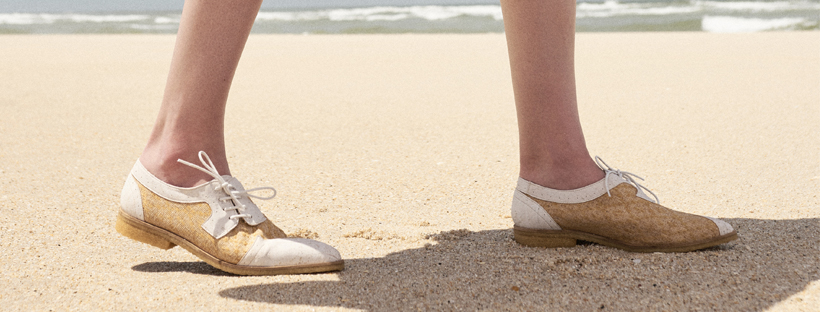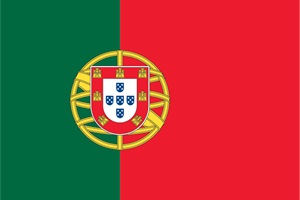Dali Azores
Marita Moreno
(
Private sector
)
#SDGAction49082
Description
The project aims to develop the production of a sustainable shoes made with handmade textile and technological material, in limited lines, articulating 4 sectors arts & crafts, technology, traditional industry and design. These areas form a collaboration and help in the creation of new products that allow the preservation of handicraft and cultural traditions and the increase of jobs in the Arts & Crafts sector. Marita Moreno is a sustainable and responsible brand, so this project also intends to present a new, more sustainable approach to the industry, with less production, more care and greater added value, as well as an intervention of the technological and design areas in new products that can help to create an aesthetically attractive shoe, but with history, heritage and soul in its creation and production.
This project started in the summer of 2018, with the AZORES collection, where 2 models were developed with two color variants each. It came about as a result of a training given by designer Marita Setas Ferro, founder and Creative Director of Marita Moreno brand, to several artisans of Terceira Island, in Azores.
The training consisted in the development of new handcrafted products, using existing handicraft skills and providing the artisans with new skills in the field of aesthetics and design. One of the artisans, Eduarda Vieira, had developed a series of samples of traditional weaving from Terceira Island, originating in the 17th century, called Repasso and used to produce quilts in virgin wool from the sheep raised in the pasture.
Due to the potential of the designs, the availability of the Artisan and the desire to continue the goals of the brand, the designer developed a series of new textiles, based on the traditional ones, minimizing the original design and maintaining the same materials - the design was reduced so that it could be used in shoes. An experimental, limited and numbered series of 25 shoes per design was then launched, with the goal of understanding the impact that this type of product - made with Portuguese cork textile and handmade textiles from the Azores - could have on the market of frequented stores in Portugal by tourists and online. The acceptance was excellent, being still one of the brand's iconic products.
Due to the success of these models and the heritage load they carried, the brand continued to research and develop new handmade textiles with the same standards, but with different materials - recycled cotton, bamboo, milk, etc. In late 2018, the brand was offered a new yarn made of cork and cotton, still under development, highly technological. Being a thread with a fine but dry touch, the brand considered it suitable for developing shoe textiles, following those it had already launched in 2018. And, after several experiences, the brand developed a handmade textile based on the Azorean Repasso to use in a classic shoe of the brand (Dali line), with the aim of launching it in the summer of 2020.
The development of this model - DALI AZORES, also limited to 20 pairs and numbered - was the trigger for a broader thinking aiming at the articulation of several areas for the production of objects of personal use with an added value in the area of heritage, technology and design. In this model, the cork textile and a handmade textile, made with a technological thread (of cork and cotton), internationally awarded, were used again. Due to the beauty of the drawings of Azorean Repasso, the brand returned to some of the designs developed initially, using a natural color palette, tone on tone.
The project began in 2018 through Sedacor's challenge to Marita Moreno to use cork-a-tex yarn (still under development by Sedacor, Têxteis Penedo and Universidade do Porto) in a shoe model to be presented in February 2019 in the application. to the TECHTEXTIL competition INNOVATION AWARD Award - 2019, CATEGORY NEW MATERIAL, GERMANY - then we created Dali Azores as an integrated design, craft, technology and industry solution. In this sense, we feel that this project was absolutely innovative and never before done in Portugal by combining these 4 sectors in one shoe. DALI AZORES has a dimension beyond the object itself and the resources used in its design and production - it managed to demonstrate that, through design management, two areas as distinct (and usually in opposite fields) as crafts and technology are able to build innovative designs and be produced in the traditional footwear industry.
The development of this model - DALI AZORES, limited to 25 pairs and numbered - was the trigger for a broader thought aimed at the articulation of Portuguese heritage, crafts, technology and design. The objective of illuminating the artisanal “know-how” crossed with technology, industry and design was fully accomplished with this project.
The model DALI AZORES, intends to be an experimental model in which traditional knowledge of handmade weaving, the aesthetics of contemporary design and the technological capacity of the Portuguese industry intersect.
Eduarda Vieira - Artisan, Sedacor, Têxteis Penedo, Grupo Morón, Cristiano Castro, Joaquim and Cristina Pereira da Cunha
SDGS & Targets
Goal 8
Promote sustained, inclusive and sustainable economic growth, full and productive employment and decent work for all
8.1
8.1.1
Annual growth rate of real GDP per capita
8.2
Achieve higher levels of economic productivity through diversification, technological upgrading and innovation, including through a focus on high-value added and labour-intensive sectors
8.2.1
Annual growth rate of real GDP per employed person
8.3
Promote development-oriented policies that support productive activities, decent job creation, entrepreneurship, creativity and innovation, and encourage the formalization and growth of micro-, small- and medium-sized enterprises, including through access to financial services
8.3.1
Proportion of informal employment in total employment, by sector and sex
8.4
Improve progressively, through 2030, global resource efficiency in consumption and production and endeavour to decouple economic growth from environmental degradation, in accordance with the 10-Year Framework of Programmes on Sustainable Consumption and Production, with developed countries taking the lead
8.4.1
Material footprint, material footprint per capita, and material footprint per GDP
8.4.2
Domestic material consumption, domestic material consumption per capita, and domestic material consumption per GDP
8.5
8.5.1
Average hourly earnings of female and male employees, by occupation, age and persons with disabilities
8.5.2
Unemployment rate, by sex, age and persons with disabilities
8.6
8.6.1
Proportion of youth (aged 15-24 years) not in education, employment or training
8.7
Take immediate and effective measures to eradicate forced labour, end modern slavery and human trafficking and secure the prohibition and elimination of the worst forms of child labour, including recruitment and use of child soldiers, and by 2025 end child labour in all its forms
8.7.1
Proportion and number of children aged 5‑17 years engaged in child labour, by sex and age
8.8
Protect labour rights and promote safe and secure working environments for all workers, including migrant workers, in particular women migrants, and those in precarious employment
8.8.1
Fatal and non-fatal occupational injuries per 100,000 workers, by sex and migrant status
8.8.2
Level of national compliance with labour rights (freedom of association and collective bargaining) based on International Labour Organization (ILO) textual sources and national legislation, by sex and migrant status
8.9
By 2030, devise and implement policies to promote sustainable tourism that creates jobs and promotes local culture and products
8.9.1
Tourism direct GDP as a proportion of total GDP and in growth rate
8.10
Strengthen the capacity of domestic financial institutions to encourage and expand access to banking, insurance and financial services for all
8.10.1
(a) Number of commercial bank branches per 100,000 adults and (b) number of automated teller machines (ATMs) per 100,000 adults
8.10.2
Proportion of adults (15 years and older) with an account at a bank or other financial institution or with a mobile-money-service provider
8.a
8.a.1
Aid for Trade commitments and disbursements
8.b
By 2020, develop and operationalize a global strategy for youth employment and implement the Global Jobs Pact of the International Labour Organization
8.b.1
Existence of a developed and operationalized national strategy for youth employment, as a distinct strategy or as part of a national employment strategy
Goal 12
Ensure sustainable consumption and production patterns
12.1
Implement the 10-Year Framework of Programmes on Sustainable Consumption and Production Patterns, all countries taking action, with developed countries taking the lead, taking into account the development and capabilities of developing countries
12.1.1
Number of countries developing, adopting or implementing policy instruments aimed at supporting the shift to sustainable consumption and production
12.2
By 2030, achieve the sustainable management and efficient use of natural resources
12.2.1
Material footprint, material footprint per capita, and material footprint per GDP
12.2.2
Domestic material consumption, domestic material consumption per capita, and domestic material consumption per GDP
12.3
By 2030, halve per capita global food waste at the retail and consumer levels and reduce food losses along production and supply chains, including post-harvest losses
12.3.1
(a) Food loss index and (b) food waste index
12.4
By 2020, achieve the environmentally sound management of chemicals and all wastes throughout their life cycle, in accordance with agreed international frameworks, and significantly reduce their release to air, water and soil in order to minimize their adverse impacts on human health and the environment
12.4.1
12.4.2
(a) Hazardous waste generated per capita; and (b) proportion of hazardous waste treated, by type of treatment
12.5
By 2030, substantially reduce waste generation through prevention, reduction, recycling and reuse
12.5.1
National recycling rate, tons of material recycled
12.6
Encourage companies, especially large and transnational companies, to adopt sustainable practices and to integrate sustainability information into their reporting cycle
12.6.1
12.7
Promote public procurement practices that are sustainable, in accordance with national policies and priorities
12.7.1
Number of countries implementing sustainable public procurement policies and action plans
12.8
By 2030, ensure that people everywhere have the relevant information and awareness for sustainable development and lifestyles in harmony with nature
12.8.1
Extent to which (i) global citizenship education and (ii) education for sustainable development are mainstreamed in (a) national education policies; (b) curricula; (c) teacher education; and (d) student assessment
12.a
Support developing countries to strengthen their scientific and technological capacity to move towards more sustainable patterns of consumption and production
12.a.1
Installed renewable energy-generating capacity in developing and developed countries (in watts per capita)
12.b
Develop and implement tools to monitor sustainable development impacts for sustainable tourism that creates jobs and promotes local culture and products
12.b.1
Implementation of standard accounting tools to monitor the economic and environmental aspects of tourism sustainability
12.c
Rationalize inefficient fossil-fuel subsidies that encourage wasteful consumption by removing market distortions, in accordance with national circumstances, including by restructuring taxation and phasing out those harmful subsidies, where they exist, to reflect their environmental impacts, taking fully into account the specific needs and conditions of developing countries and minimizing the possible adverse impacts on their development in a manner that protects the poor and the affected communities
12.c.1
Amount of fossil-fuel subsidies (production and consumption) per unit of GDP
SDG 14 targets covered
| Name | Description |
|---|
Deliverables & Timeline
The development of this model - DALI AZORES, limited to 25 pairs and numbered - was the trigger for a broader thought aimed at the articulation of Portuguese heritage, crafts, technology and design. The objective of illuminating the artisanal “know-how” c
Resources mobilized
Partnership Progress

Feedback
Action Network

Timeline
Entity
Region
- Europe
Geographical coverage
Other beneficiaries
Final Consumer, Industry, Artisans and Crafters, Designers
More information
Countries


Contact Information
Marita Setas Ferro, CEO

